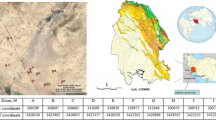Summary
-
1.
During roadway drivage in the permafrost zone, the yield of fine dust fractions increases with falling temperature and we therefore observe an increase in the dust-formation intensity.
-
2.
The increase in dust-formation intensity is due to a change in the frozen rock's physicomechanical properties (hardness, brittleness, viscosity and moisture content).
-
3.
The authors' empirical equations can be used for forecasting the dust-formation intensity during mining of different zones and horizons with different geocryological conditins, so as to calculate the optimal ventilation conditions.
Similar content being viewed by others
Literature Cited
V. P. Bakakin, Fundamentals of Mining Operations Under Permafrost Conditions [in Russian], Moscow, Gosgortekhizdat (1958).
O. V. Khoroshev and M. A. Dukhovnyi, The use of statistics for processing the results of dust investigations. In the Symposium: “Sci. Work of KGRI”, No. 5 [in Russian], Moscow, Gosgortekhizdat (1956).
P. I. Tyutin, Determination of the mineral composition, particle size and specific surface of dust by the petrographic method. In Symposium: “Suppression of Silicosis”, No. 3 [in Russian], Sverdlovsk, Izd. Ural'skoi Komissii po Bor'be s Silikozom (1961).
V. N. Vorotin, L. D. Voronina, and A. D. Bagrinovskii, Handbook of the Planning and Practice of Dust Suppression in Metal Mines [in Russian], Moscow, Gosgortekhizdat (1961).
Z. A. Narsesova, Phase Composition of Ground Water during Freezing and Thawing, Laboratory Research on Frozen Soils, No. 1 [in Russian], Moscow, Izd. AN SSSR (1953).
L. S. Burshtein and L. N. Kurochkin, Study of the Physico-mechanical properties of frozen bedrock. In Symposium: “Thermal and Mechanical Processes in the Mining of Minerals in Rocks” [in Russian], Moscow, “Nauka” (1965).
A. D. Frolov and A. A. Smirnov, Some results of a study of the propagation of ultrasound in specimens of frozen rocks. In Symposium: “Permafrost Research” [in Russian], Moscow, Izd. MGU (1961).
I. A. Tyutyunov, Changes and Conversion of Soils and Rocks at Negative Temperatures [in Russian], Moscow, Izd. AN SSSR (1960).
Additional information
ZabNII, Chita. Translated from Fiziko-Tekhnicheskie Problemy Razrabotki Poleznykh Iskopaemykh, No. 4, pp. 121–125, July–August, 1967.
Rights and permissions
About this article
Cite this article
D'yakov, V.V., Voronov, E.T. Intensity of dust formation under permafrost conditions. Soviet Mining Science 3, 414–417 (1967). https://doi.org/10.1007/BF02497568
Received:
Issue Date:
DOI: https://doi.org/10.1007/BF02497568




